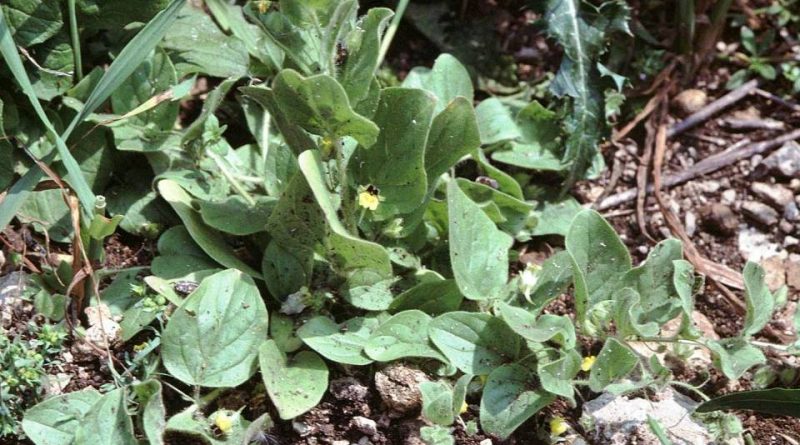Kickxia spuria
Kickxia spuria
The Round-leaved Fluellen (Kickxia spuria (L.) Dumort., 1827) is a herbaceous species belonging to the Plantaginaceae family.
Systematics –
From a systematic point of view it belongs to:
Eukaryota Domain,
Kingdom Plantae,
Subarign Tracheobionta,
Spermatophyta superdivision,
Magnoliophyta Division,
Magnoliopsida class,
Subclass Asteridae,
Order Scrophulariales,
Scrophulariaceae family,
Antirrhineae Tribe,
Genus Kickxia,
K. Spuria species.
Basionimo is the term:
– Antirrhinum spurium L ..
The terms are synonymous:
– Antirrhinum rotundifolium Gilib .;
– Cymbalaria spuria (L.) P. Gaertn .;
– Elatine ovata Moench;
– Spurious Elatine (L.) Fourr .;
– Elatinoides spuria (L.) Kuntze;
– Linaria spuria (L.) Mill.
Within this species, the following subspecies is recognized:
– Kickxia spuria subsp. integrifolia (Brot.) R.Fern., 1971.
Etymology –
The term Kickxia of the genus was dedicated to Jean Kickx (1775-1831) born in Brussels, professor of Botany, Pharmacy and Minerology, author of Flora Bruxellensis (1812).
The specific spurious epithet means false, bastard, illegitimate, spurious.
Geographic Distribution and Habitat –
The Round-leaved Fluellen is a plant of Eurasian or even Mediterranean origin, probably of ancient introduction with crops (archaeophyte), present in all regions of Italy except in the Aosta Valley.
Outside Italy, still in the Alps, this species is found in France (all Alpine departments), in Switzerland (cantons of Bern and Valais), in Austria (Länder del Vorarlberg and Lower Austria) and in Slovenia. On the other European reliefs connected to the Alps it is found in the Black Forest, the Jura Massif, the Central Massif, the Pyrenees, the Dinaric Alps, the Balkan Mountains and the Carpathians. In the rest of Europe and the Mediterranean area, K. spuria is present from Spain to Greece (up to the borders towards Russia) and from Great Britain to Sicily; it is also present in Anatolia, Mediterranean Asia, Egypt and the Maghreb.
Its typical habitat is that of fields and vineyards. The preferred substrate is calcareous but also siliceous with neutral pH, high nutritional values of the soil which must be moderately humid. Its altitudinal distribution is up to 1,000 m above sea level.
Description –
Kickxia spuria is an annual herbaceous plant, with a 20-40 cm stem, branched at the base, supple, partly always prostrate and with ascending branches, equipped with dense patent hair.
The leaves are ovate, alternate, hairy, with a heart-shaped or rounded base, entire margin, short petiole.
The flowers are solitary at the axil of the leaves. the corolla is bilabiate, yellowish in color and provided with a curved spur.
It blooms in the period of June-July.
The fruit is a porous capsule of 3-4 x 3.5-4.5 mm, fragile, subglobose, depressed, pubescent at the apex and hairless when ripe. The seeds of 07-1 x 0,5-0,8 mm are ellipsoid or obovoid, reticulated, of a dark brown color.
Cultivation –
Kickxia spuria is a plant that grows spontaneously in crops, olive groves, vineyards, cereal crops, beets, etc. and loose soils, developing fully after harvest, below the lower mountain belt.
This plant is present on various continents as an introduced species and sometimes fought as a noxious weed.
Customs and Traditions –
Kickxia spuria is a plant similar to its relative, Kickxia elatine, but which is distinguished by the shape of the leaves and the stem and flowers.
Both this species and Kickxia elatine are considered weeds that grow in cereal fields after the harvest is complete. Probably these are plants whose dispersion due to man is of remote origin (archaeophytic plants).
Of this plant, especially in the past, both the whole plant and the flowers were used for medicinal use, even if in this regard there is little information and research on the matter.
Preparation Method –
Above all, once upon a time both the whole plant and the flowers were used of the Kickxia spuria, most likely in the form of infusions or decoctions even if, in this regard, little is known.
Guido Bissanti
Sources
– Acta Plantarum – Flora of the Italian Regions.
– Wikipedia, the free encyclopedia.
– Useful Tropical Plants Database.
– Conti F., Abbate G., Alessandrini A., Blasi C. (ed.), 2005. An annotated checklist of the Italian vascular flora, Palombi Editore.
– Pignatti S., 1982. Flora of Italy, Edagricole, Bologna.
– Treben M., 2000. Health from the Lord’s Pharmacy, Advice and experiences with medicinal herbs, Ennsthaler Editore.
Warning: Pharmaceutical applications and alimurgical uses are indicated for informational purposes only, they do not represent in any way a medical prescription; therefore no responsibility is taken for their use for curative, aesthetic or food purposes.


